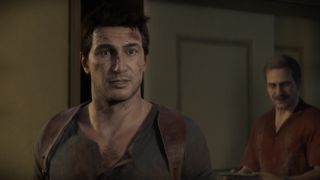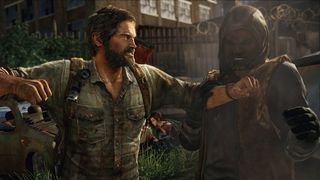Uncharted 4 has learned a lot from The Last of Us, and looks much better for it
I didn’t love Uncharted 3. I had a good time with it, but that was it. It’s a well-produced, slickly designed game, with a great sense of spectacle, but ultimately, it all just felt a little hollow. It just didn’t thrill me, not the way Uncharted 2 did. The reason? It felt like a classic example of ‘Third Game In The Trilogy But Part Two Was Perfect What The Hell Do We Do Now?’ Syndrome. Not the smoothest-named syndrome in media history, I’ll grant you, but in half a generation’s time, we’ll all be discussing it as naturally as we say ‘Star Wars’, and with just as little regard for the objectively stupid wording.

But you know what? I’m really excited about Uncharted 4. Far from running an already-done concept into the ground, it looks to be – like the other big four-quels of this year’s E3, Gears, Fallout and Doom – taking the opportunity to cut loose from the expectations set by its predecessor, stepping away from the trilogy to make a fresh start. And it’s doing so by taking direct inspiration from a seemingly very different stable-mate.
Ostensibly, Uncharted and The Last of Us have little in common. One is the rollercoaster romp of a charismatic, infeasibly upbeat, Not-Nathan-Fillion. It’s about enjoying all manner of ludicrously cinematic escapades while having so much spellbinding, popcorn fun we forget that we’re murdering thousands of guys whose motivations are little more cynical than Nate’s own. The other is the slow, brutal, resolutely real tale of a depressed, self-hating old burnout who responds to every one of his own (distressingly intimate) violent actions almost as badly as his victims do, all while trying inexpertly to protect the one person he accidentally gives a shit about. While pretending not to give a shit. But you know what? I can see a lot of The Last of Us in Uncharted 4’s E3 demo. And that has reinvigorated my interest in the game no-end.
‘Reinvigoration’ is what it’s all about really. Because where Uncharted 3 tried to keep things fresh by simply turning the volume up, U4 is refreshing Uncharted’s cinematic action schtick by finding news ways to present it. And the DNA of those new methods looks to be coming straight out of Naughty Dog’s downbeat, apocalyptic epic.

Rather than just going bigger, Uncharted 4 seems to be going wider. One of the best cards in The Last of Us’ deck of believability is the way in which it gives a resolutely linear game the captivating sense of playing out in a real, fully featured world. It’s a game of designated start-points and end-points, but in between those you’ll find wide, open areas for both improvised strategy and narrative-fuelling exploration. It’s a game with a prescribed journey, but its vast-yet-intricate set dressing, and its less stringent enforcement of the pace and path of your exploration, make it feel anything but. It’s a game in which a grand illusion of openness and freedom allows a much more naturalistic experience to blossom, while always quietly, deftly nudging you to where you need to be.
Preciously, Uncharted did not work like that. It didn’t need to. Rollercoasters do not give steering wheels to their riders. That’s not what they’re about. Yes, Uncharted’s shooting had always had a great degree of excitingly fluid freedom, its miniature sandbox combat grounds and facility for organic, chaotic run-and-gun delivering little patches of exploration and expression along the trail. But those are self-contained freedoms. Little spot arenas in which to play, enclosed within a rigid funnel.
For a long time, that was absolutely fine. Great, in fact. Not every game needs to be Skyrim, and there are plenty of brilliant experiences that a fully free-roaming game just cannot deliver. But the problem with a rigid framework is that however big the scripted spectacles it supports, eventually you’re going to hit its limits. And that’s what Uncharted 3 was for me. A series of massive stand-out moments that only had massiveness to work with, due to having no freedom within which to explore other options.
Sign up to the GamesRadar+ Newsletter
Weekly digests, tales from the communities you love, and more
But good Lord, that Uncharted 4 E3 demo. The one that had Leon giddy, and hyperventilating, and accusing Naughty Dog of ‘just taking the piss now’. It’s massive. It escalates exponentially. But you know why it really excited me? Because I know I only saw about a third of it. Because the approach Naughty Dog took to The Last of Us’ empty towns and rambling countryside is in full force.
Look at how often Nath and Sully veer off the road and find new paths. Look how many of the series’ trademark, dev-designed, marvellously paced set-pieces happen along those paths. Nothing is vastly bigger than we’ve come to expect from the series, but the whole experience feels immense, because the set-pieces have room to breathe, and because they all feel like optional, truly dynamic events in a captivating, fully-featured world. That’s where Uncharted needed to go. Not bigger in terms of the scale of the individual scripted moments on the conveyor belt, but bigger by way of amplifying those moments, using a more nuanced sense of reality and freedom to reduce the sense that they are scripted.
You can see The Last of Us’ influence elsewhere too. In the way that Sully’s greater, more active presence makes the on-foot action feel more dynamic, more human, riskier,and more unpredictable, even though the core cover-shooting has change little. In the way that Nate’s adopted dad charges in from off-camera to spark out a goon who’s giving the kid trouble, an act that plays for all the world like a more slapstick rendition of Joel and Ellie’s interplay.

We even saw hints of this stuff in Uncharted 4’s earlier reveal footage. Remember those combined climbing and combat areas, with the multiple cliffs and rocky spires? Drake’s moveset and opposition might have been familiar, but his options certainly weren’t. Where Uncharted 2 would have wrapped a sweeping backdrop around a linear sequence of ‘jump across this, shoot this guy who isn’t looking, choke out this other guy who isn’t looking, oh crap, gunfight!’, U4’s multi-directional, wall-free maze of stealth options, firing lines, enemy activity and orientation possibilities has a very real, albeit abstracted, sense of Joel’s rangey, do-as-thou-wilt combat philosophy, now with added verticality™.
That’s the great thing about game development. The ‘development’ part. It doesn’t always come from the sources, or even projects, that you expect, but the big old bee swarm of new ideas is always buzzing overhead, shifting, changing shape, and cross-pollinating. For me, Uncharted had run out of steam not because of its ideas or core gameplay, but because the frame that contained them no longer sufficed. But where Naughty Dog could not free Uncharted from within the series, it was free to explore the new rules of a new world in The Last of Us. And it looks like it has absolutely done that, and broad a whole lot of that world back to rebuild things anew.

Diablo 4 dev is sending 666 buckets of literal bugs to "meat their maker" at a charity for hungry birds

The cult vampire third-person shooter that nearly bankrupted the small studio that made it is getting a film adaptation from the Transformers producer

Fallout mod site says it's like players are downloading Skyrim "twice every second" after Amazon TV series drives fans back to the open-world RPGs
Most Popular





